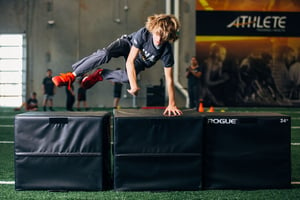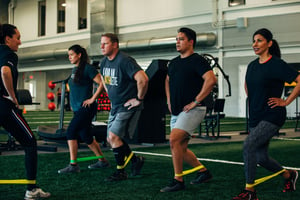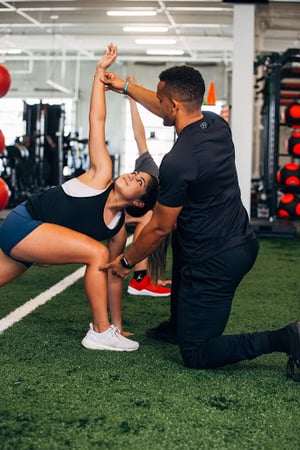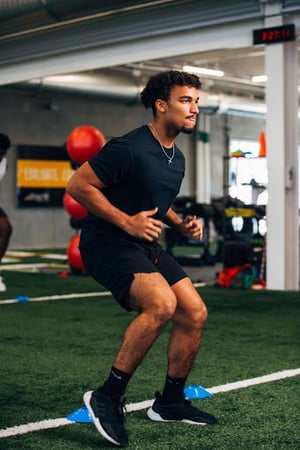By Former ATH Athletic Performance Director Frank Bourgeois, PhD; Performance Coach Aubrey Carroll, BS; and Performance Coach Mac Graham, CSCS
Why get warm?
How often do you walk into the gym feeling unorganized, cold or lacking motivation? Have you ever sat down to think about how you need to prepare not only your body, but also whether or not you even need to warm up in the first place? Here at ATH we pride ourselves on how we design a warm up that would prepare anyone from age 8 to age 80 for their training of the day.
In brief, everyone should always warm up no matter how they are planning to train that day. Ample warm ups help us prepare for the training session in not only a physical manner, but also mentally. It helps us get into the proper mindset to be fully focused on the movements we are about to perform. Physically, warm ups help our bodies perform at their strongest and fastest. Besides preparing us to be our best, it also lets us know if we may or may not need to back off for that day. This could be noticed through tightness that has not been there before, or potential aches or pains found throughout different movements. Warm ups also give us a chance to practice any movements that we could be performing in that training session.
Here at ATH, we utilize a structured warm up for all of our classes based around the RAMP principle, which stands for: Raise, Activate, Mobilize and Potentiate. The details of each RAMP component are as follows:
Raise

The “R” in RAMP stands for the aim to raise overall body temperature to get yourself warm. This portion of our warm ups attempts to accomplish this by increasing our heart rate to help increase blood flow.
Our bodies work like ovens, not microwaves, they need ample time to get warm enough to work effectively. When it comes to increasing blood flow, we look to promote this function due to the fact that blood is vital for our muscles and more so living.
Additionally, raising body temperature improves the state of our body's synovial fluid which helps lubricate all joints. All it takes is any activity that can be done for a period of 2-5 minutes. With that being said, here are some practical examples of how we can Raise our heart rate and body temperature:
- At ATH: We incorporate primal movements such as shuffles, backpedals and a jog series to get your heart rate up.
- Not at ATH? Use any cardio equipment you can get your hands on: rower, assault bike, stationary bike, Jacob’s Ladder, etc.
- Got a group? Play a game: Sharks and Minos, Freeze tag, or if the circumstances allow and everyone is feeling brave - Dodgeball.
Activate

Once we have gone through our Raise portion of our warm up, we then get a little more specific with the movements and the day’s training goals with the Activate section. For this part of the warm up, we are looking to get specific body parts/muscles moving before we put them under any type of significant load.
When we are looking to activate our muscles, we are working to excite the nerves that innervate specific muscles we are looking to use, as well as increase mobility. As we mentioned earlier, this can be a time to practice any movements that would be performed during that day’s training. And for those who struggle with previous injuries, it is during this time those troubled areas receive extra attention.
Upon raising the temperature of the body, it is important to activate the specific muscle groups and movement patterns that you will focus on during your training that day. Doing so primes both the physical and mental aspects of training and will help set you up to be at your best throughout the session.
Heading into a few Activate movement examples, it should be noted these are going to typically be done in reps of 5-12 depending on the movements in that day’s workout. The following examples are broken down by basic movements that could be the main lift/exercise for the day:
- A squat-emphasis day: Bodyweight squats, walking lunges, banded walks
- Hinge-emphasis day (deadlift/RDL): Single leg RDL, good morning with PVC pipe/dowel
- Push-emphasis day (overhead press/bench press): Push-ups, bear crawls, halos with a kettlebell, mini banded shoulder series
- Pull-emphasis day (rows, pull ups): Bent over rows with a big band, pullovers with big bands, I’s Y’s and T’s lying face down
Mobilize

By this point in the warm up, we are now in a position to where we will want to walk through any potential limitation in ranges of motion we may be aware of. For many adults who work jobs that require them to be at a desk and on a computer, it is not uncommon for there to be tightness in their shoulders or back. So, we need to make a point to get to our third phase: Mobilize.
When we sit down for extended periods of time (6-8 hours a day, multiple days a week), the muscles in our hips adapt to that position and become used to the shortened state they are in. If our muscles get tight in those scenarios, we can address it here. Since, at this point in our warm up we have our body temp up and blood flowing in our muscles, it is important to work them through their proper ranges of motion. As we get those muscles moving, it will make performing our exercises all the better.
All of the stretches provided here as an example are meant to be performed in motion. These types of stretches are referred to as dynamic stretches. Examples of dynamic stretches that are listed below and can be done in the rep range of 5-10.
- Alternating knee hug to quadricep pull, the world's greatest stretch, over and backs with a PVC pipe, inchworm crawls, T-spine rotations from quadruped position, and toy soldier marches
Potentiate

As humans, we are always moving, but as we age the focus swings from bettering our ability to maintaining our ability. By finishing our warm up with Potentiate, we’re increasing our ability to move more explosively (quickly/stronger). For younger athletes, there needs to be a focus on developing movement to be able to move as fast and as strong as possible. For those of us who are maintaining movement, the need to emphasize moving quickly and strongly remains because we all reach a point in our lives where once it is lost, it is gone for good.
To get into that zone of potentiation, the movements we chose need to be at a pretty high intensity (think jumping/skipping). This portion of our warm up will need to be high paced, and can be as simple as doing basic change of direction drills or a series of jumps.
Keep in mind these movements should be done in short bursts with adequate amounts of rest in between reps. It is also important to note that since these movements are more difficult and require more effort, they should be performed in reps of 3-5 in 1-2 rounds.
These movements are the most effective for Student ATHletes:
- Pogos for 5 yards, broad jumps, depth drops, A-skips, box jumps, bounding and shuffle/sprint series
These moments are the most effective for Forever ATHletes:
- Shuffle series, run series, burpees, depth drops
Try it yourself!
Remember, you cannot put cookies into a cold oven and expect it to make warm cookies in 10 minutes. Using the RAMP principles of warming up, you can mentally and physically prepare for any workout that you are hoping to complete. Within the principles laid out here, the only limitation is how creative you can be. Warming up does not have to be something that delays your actual workout. It can be a great tool that will help you take complete advantage of every workout.
We design the following as a template to help you get an idea of what a RAMP warm up could look like for a High Intensity Interval Training (HIIT) session.
RAISE:
- Jog outside for 4 minutes or inside with warm clothing on to help raise your temperature.
ACTIVATE:
- Walking lunges - 5 steps on each leg
- Bear crawl - 10 yards or 15 steps with hands (or feet)
- Lateral Lunge - 5 on each leg
- Single Leg RDL - 10 on each leg
- Bent over rows with big band - 10 reps
- Upright rows with big band - 10 reps
MOBILIZE:
- World’s greatest stretch - 5 reps on each side
- Inchworms - 6 reps
- Quad pull with calf raise - 10 reps on each side
- Over hurdle steps - 10 reps on each leg
POTENTIATE:
- Shuffle change of direction series (Shuffle 5 yards to stick, shuffle 5 yards then cut back, shuffle 5 yards and turn and sprint back)